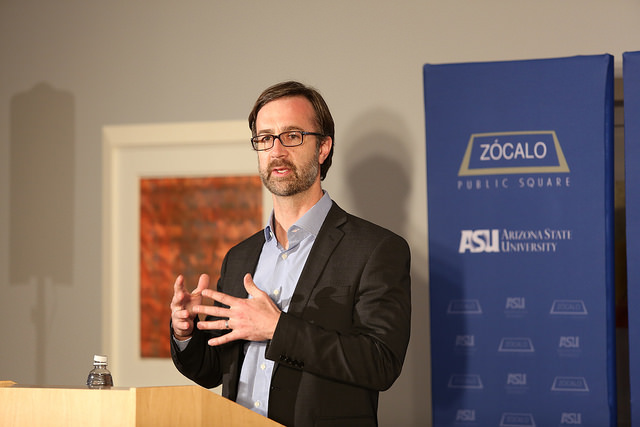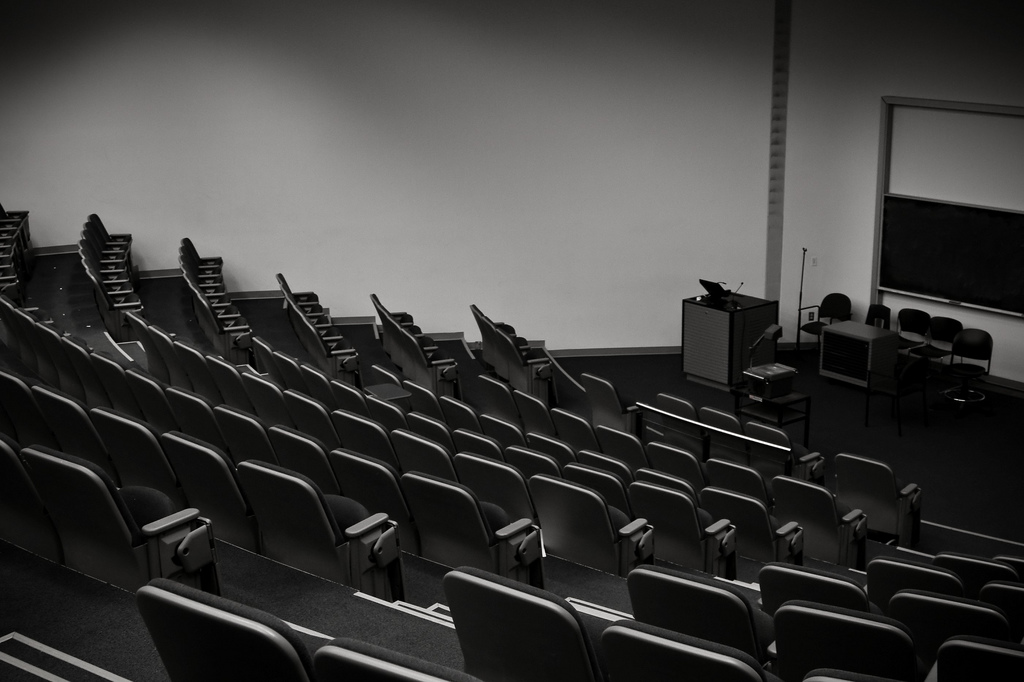
American society is obsessed with change and the future—yet our institutions of higher education love to advertise how long they’ve been around. Why? Kevin Carey, author of The End of College and education policy director at the New America Foundation, told a crowd at the ASU Art Museum that it’s because universities want to signal to us that they’ve always been here—and will always be the same. However, “that’s not really true,” he said. At an event co-presented by Arizona State University, Carey explained how American universities evolved, and where he thinks they’re heading next.
The first Ph.D. was not granted until 1861, at the start of the Civil War, he said. At that time, as America changed, colleges shifted from institutions that enrolled very few people—most of whom wanted to become clergy—into what Carey calls “hybrid universities” tasked with doing three very different things. One was practical— educating people to enter professions and become citizens. The second was to follow the model of the German research university, and perform the most important scholarship. The third was to offer students a liberal arts education, teaching them how to think, lead the good life, and be human—replacing the explicitly religious values that had informed colleges up to that point.
Over the course of a few decades, universities around the U.S. adopted this hybrid model. Ph.D.s became the required credential for teaching at the best institutions. The ideas of academic freedom and scholarly independence took hold.
This model was successful for a very long time, even as various scholars predicted its death. But the American university didn’t necessarily succeed on its merits. Rather, said Carey, “American colleges and universities have been on something of an epic string of good luck over the last 80 or 90 years that we ought not to assume will continue.” That luck derived from a mix of political, social, and economic factors—from two world wars that decimated European universities and the G.I. Bill to the growth of the American middle class and the nation’s transformation from a blue-collar to a white-collar economy.
By 1980, said Carey, America had stopped building colleges. As a result, universities beaome national institutions competing to outrank one another. At the same time, states started slashing taxes and cutting education funding. And so tuitions grew “somewhat heedlessly” more expensive, said Carey. But people kept paying. Universities had a captive market of young people who wanted to get jobs, and parents who wanted the best for their kids.
Paying for college became a source of increasing anxiety, said Carey. Today, the one thing anyone you talk to on the street knows about higher education is that “it might bankrupt them,” he said.
At the very same time, information technology arrived on the scene—and finally became capable of altering the face of education. This isn’t the first time we’ve predicted that new technology would disrupt old education models. Carey said that Thomas Edison said that K-12 schools would be replaced with movie theaters.
However, this time is different. Technology allows schools do some of the things they want to do better—and to do what they’re already doing for a lot more people at much lower cost per student. This, said Carey, “is a surprisingly controversial thing to say even though it seems very clearly true to me.”
College classes are predominantly lecture classes. It’s difficult to put a laboratory course, a seminar, or a dance class online. But in America, the most popular major by far is business. Carey believes that much of a business education can translate to a format and method, aided by technology, that costs much less than what students are paying today.
“I think we are right now in the midst of a transformation from a time of scarcity to a time of abundance of educational resources, and I think that’s a wonderful thing,” said Carey. As poverty continues to decline, it will be impossible to give the growing global middle class a traditional American university education. We are going to have to figure out another way.
In the audience question-and-answer session, Carey was asked to elaborate on what the university of the future will look like.
Will the massive infrastructure that universities have currently set up—perhaps best embodied by the difficulties of parking on a traditional campus—be gone?
Carey said that once you build up a research university, it costs a lot of money to maintain. The competition for status among colleges is physical; they always have to be building. As a result, campuses are much nicer than they were in the 1960s and 1970s. “We obligate undergraduates to pay for the nicest gym they’ll ever belong to in their lives at a point when they don’t have that much money,” he said.
Community colleges, he predicted, can become smaller facilities with greater capacity and fewer bells and whistles.
There will also be a fundamental transformation in the relationship between alumni and their alma maters. College is one of the only sources of lifetime tribal identification people have in our dispersed society. Yet it consists of four years of coming of age—and then a lifetime of “professional sports and begging for donations,” said Carey. What if that long-term relationship instead made people part of a lifelong educational community? That, said Carey, just might be a more authentic university community.






Send A Letter To the Editors